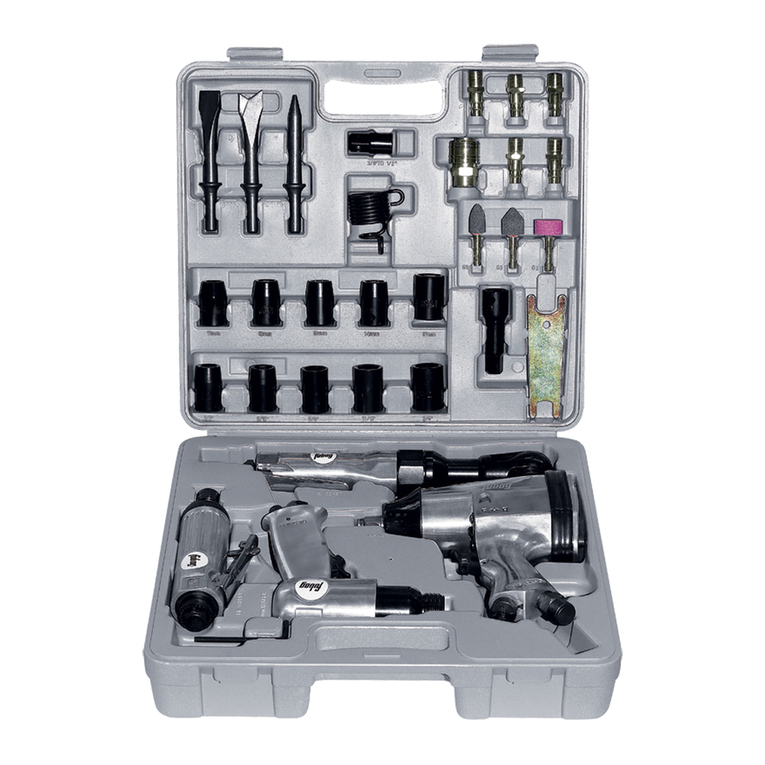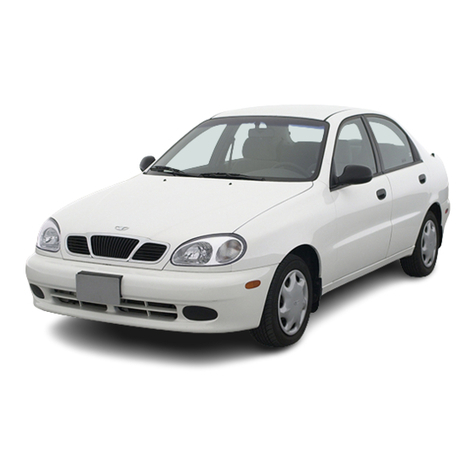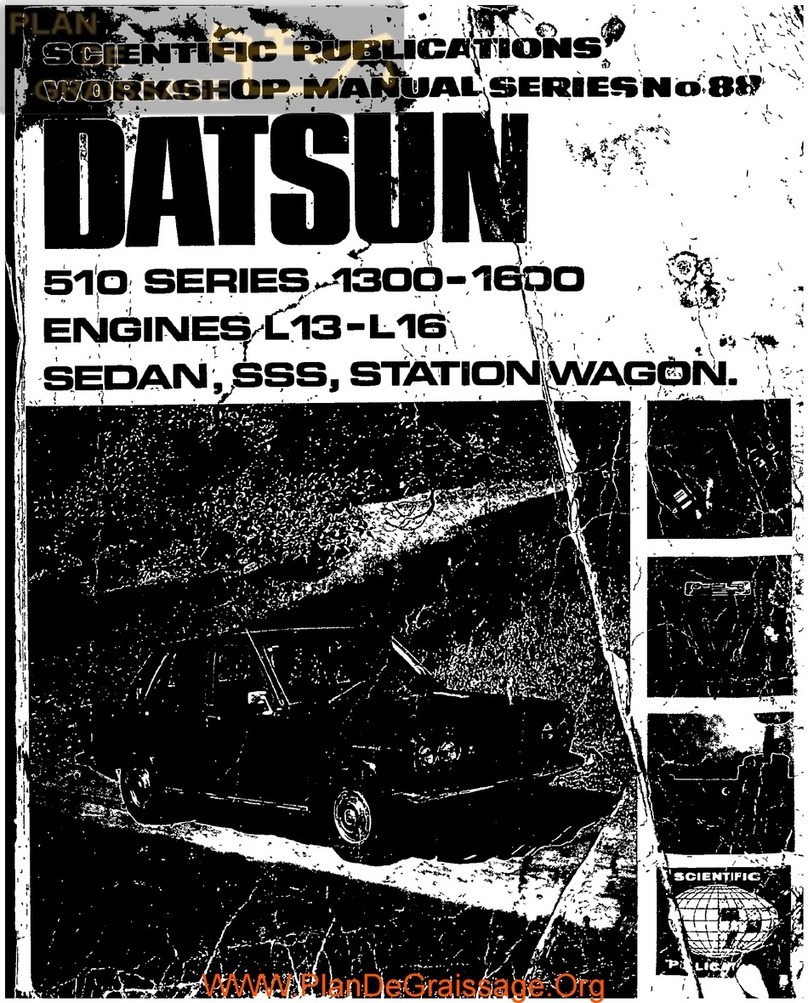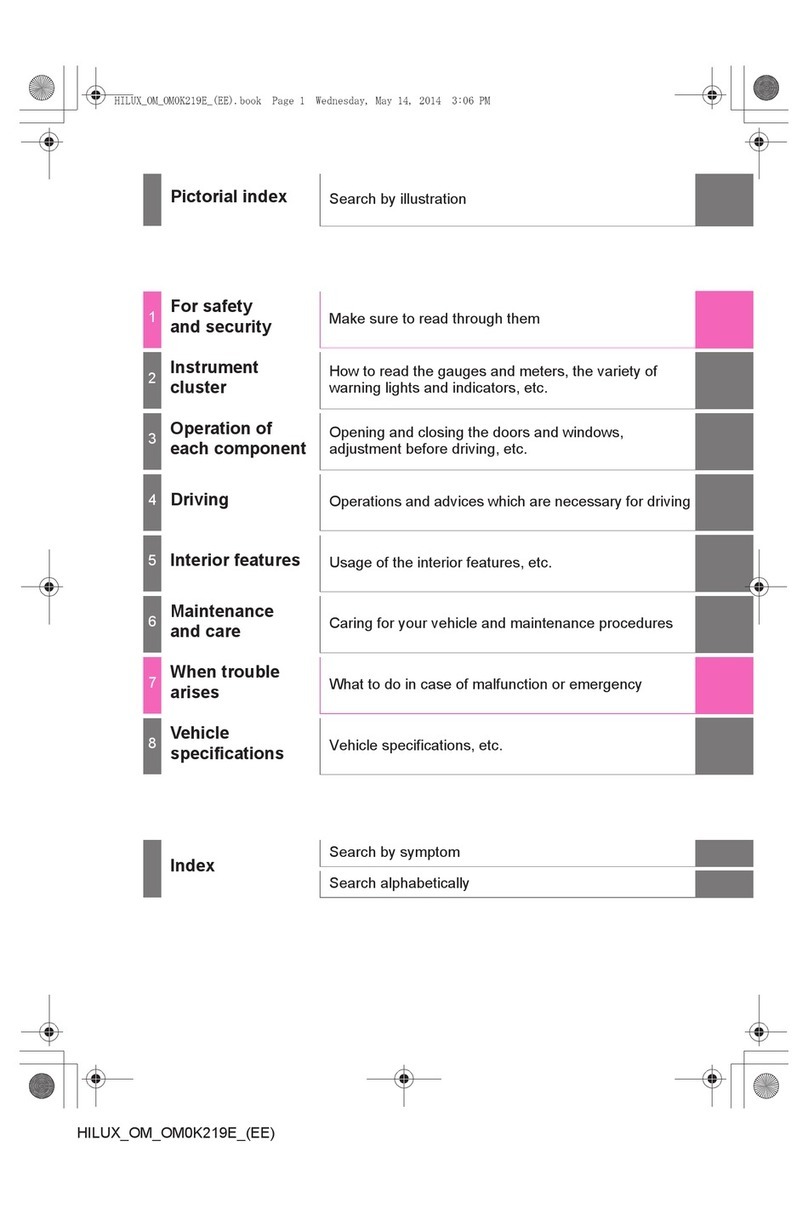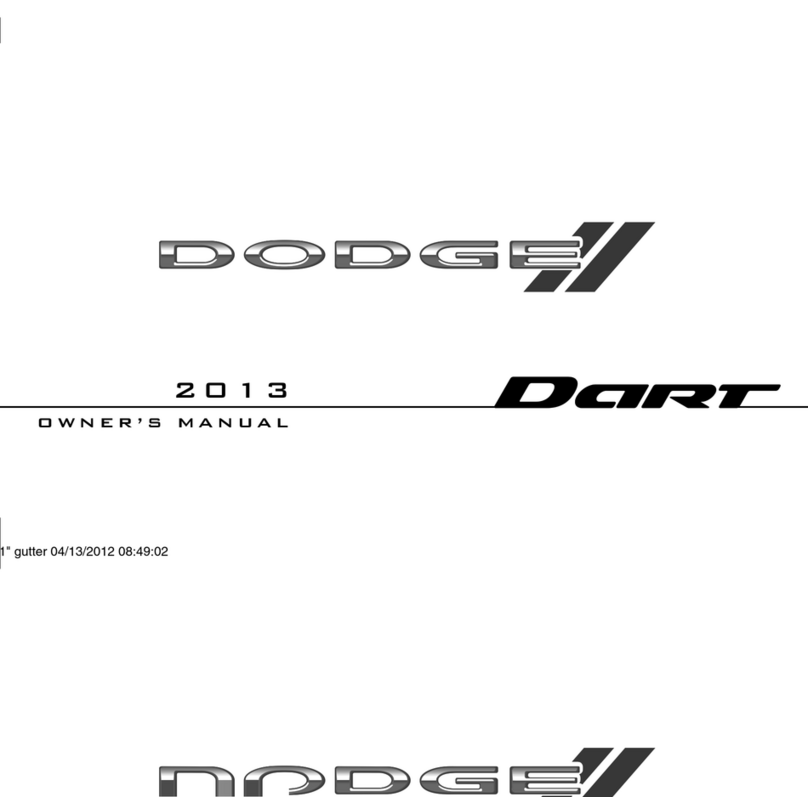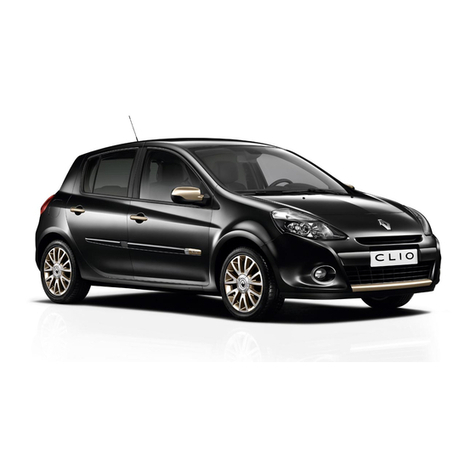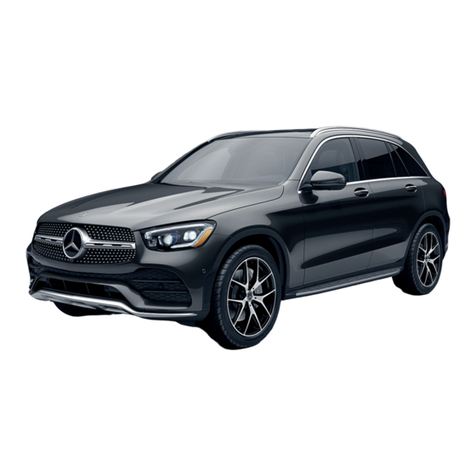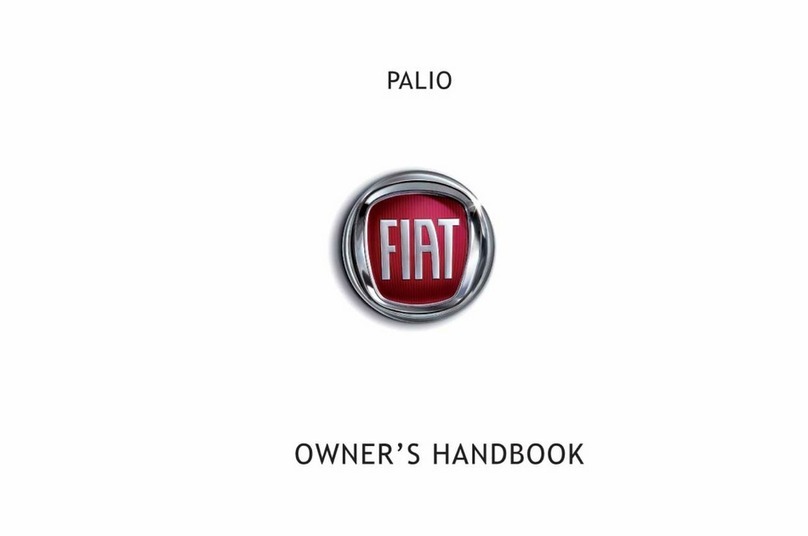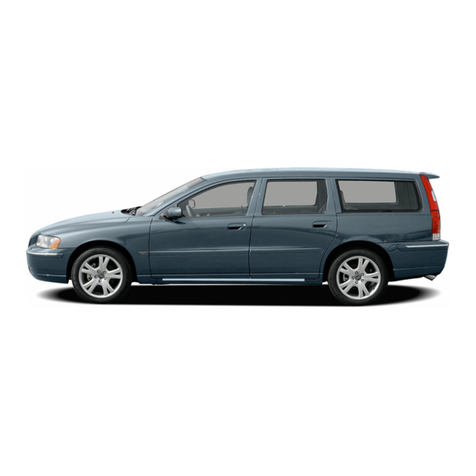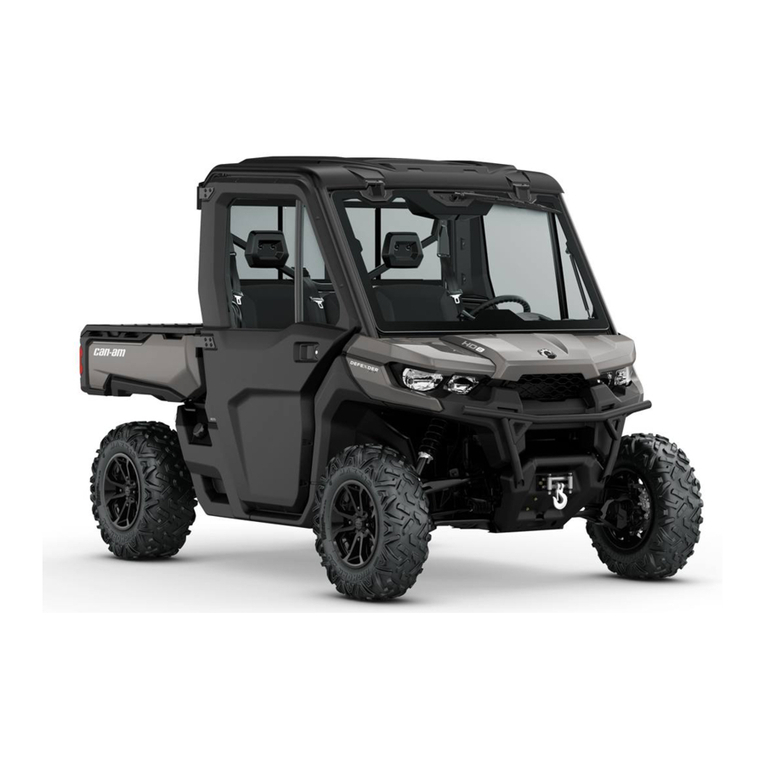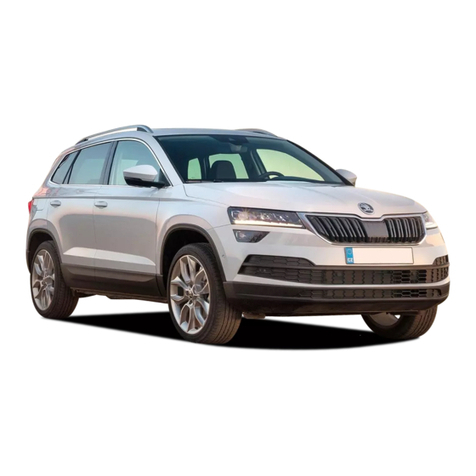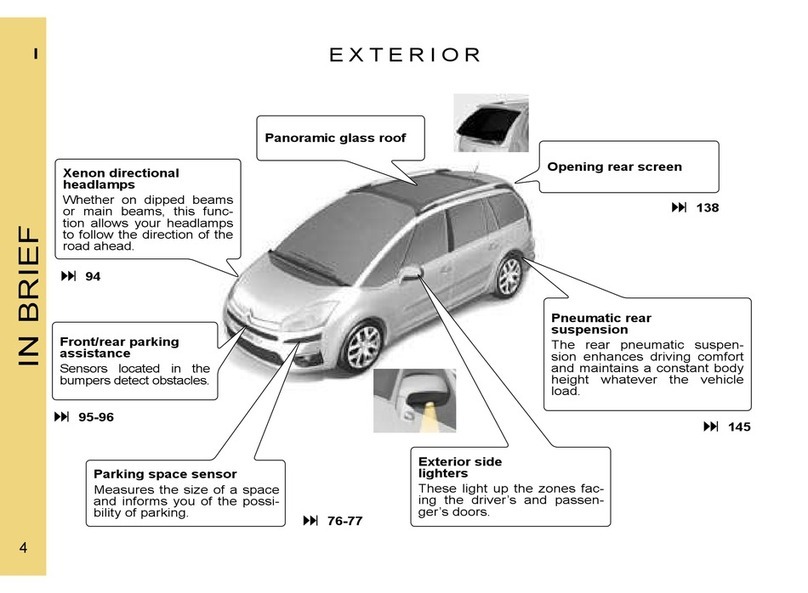Daewoo NUBIRA User manual


SECTION : 0B
GENERAL INFORMATION
TABLE OF CONTENTS
SPECIFICATIONS 0B–1. . . . . . . . . . . . . . . . . . . . . . . . . .
TECHNICAL DATA 0B–1. . . . . . . . . . . . . . . . . . . . . . . .
VEHICLE DIMENSIONS AND WEIGHTS 0B–5. . . . .
STANDARD BOLT SPECIFICATIONS 0B–7. . . . . . . .
MAINTENANCE AND REPAIR 0B–8. . . . . . . . . . . . . . .
MAINTENANCE AND LUBRICATION 0B–8. . . . . . . . . .
NORMAL VEHICLE USE 0B–8. . . . . . . . . . . . . . . . . . .
EXPLANATION OF SCHEDULED MAINTENANCE
SERVICES 0B–8. . . . . . . . . . . . . . . . . . . . . . . . . . . . . .
SCHEDULED MAINTENANCE CHARTS 0B–10. . . .
OWNER INSPECTIONS AND SERVICES 0B–12. . . . .
WHILE OPERATING THE VEHICLE 0B–12. . . . . . . .
AT EACH FUEL FILL 0B–12. . . . . . . . . . . . . . . . . . . . . .
AT LEAST MONTHLY 0B–12. . . . . . . . . . . . . . . . . . . . .
AT LEAST TWICE A YEAR 0B–12. . . . . . . . . . . . . . . .
EACH TIME THE OIL IS CHANGED 0B–13. . . . . . . .
AT LEAST ANNUALLY 0B–13. . . . . . . . . . . . . . . . . . . .
RECOMMENDED FLUIDS AND LUBRICANTS 0B–15
GENERAL DESCRIPTION AND SYSTEM
OPERATION 0B–16. . . . . . . . . . . . . . . . . . . . . . . . . . . . .
GENERAL REPAIR INSTRUCTIONS 0B–16. . . . . . .
GENERAL DESCRIPTION 0B–17. . . . . . . . . . . . . . . . . .
ON BOARD REFUELING VAPOR RECOVERY
SYSTEM 0B–17. . . . . . . . . . . . . . . . . . . . . . . . . . . . . .
VEHICLE IDENTIFICATION 0B–20. . . . . . . . . . . . . . .
VEHICLE LIFTING PROCEDURES 0B–24. . . . . . . . .
SPECIFICATIONS
TECHNICAL DATA
Performance – Manual Transaxle
Application 2.0L DOHC
Maximum Speed 195 km/h (122 mph)
Gradeability 0.446 (tan Ø)
Minimum Turning Radius 5.3 m (17 ft)
Performance – Automatic Transaxle
Application 2.0L DOHC
Maximum Speed 190 km/h (119mph)
Gradeability 0.668 (tan Ø)
Minimum Turning Radius 5.3 m (17 ft)

0B – 2IGENERAL INFORMATION
DAEWOO V–121 BL4
Engine
Application 2.0L DOHC
Engine Type Dual Overhead Cam L–4
Bore 86 mm (3.4 in.)
Stroke 86 mm (3.4 in.)
Total Displacement 1 998 cm3(121.9 in3)
Compression Ratio 9.5µ0.2:1
Maximum Power 96 kW (128.7 bhp)
(at 5,400 rpm)
Maximum Torque 184 NSm (135.7 lb–ft)
(at 4,400 rpm)
Ignition System
Application 2.0L DOHC
Ignition Type Direct Ignition System
Ignition Timing 8³BTDC
Ignition Sequence 1–3–4–2
Spark Plug Gap 0.8 mm (0.031 in)
Spark Plug Maker Bosch
Spark Plug Type FR8LDC4
Clutch – Manual Transaxle
Application 2.0L DOHC
Type Single Dry Plate
Outside Diameter 225 mm (9.0 in.)
Inside Diameter 150 mm (5.9 in.)
Thickness 3.4 mm (0.13 in.)
Fluid Capacity Common Use; Brake Fluid
Manual Transaxle
Application 2.2L DOHC
Maker DWMC
Type or Model D–20
Gear Ratio: –
1st 3.545:1
2nd 2.158:1
3rd 1.478:1
4th 1.129:1
5th 0.886:1
Reverse 3.333:1
Final Drive Ratio 3.550:1
Oil Capacity 1.8L (2 qt)
* Puerto Rico only.

GENERAL INFORMATION 0B – 3
DAEWOO V–121 BL4
Automatic Transaxle
Application 2.0L DOHC
Maker GM
Type or Model 4T40E
Gear Ratio: –
1st 2.957:1
2nd 1.623:1
3rd 1.000:1
4th 0.682:1
Reverse 2.143:1
Final Drive Ratio 3.910:1
Oil Capacity 11.5L (12 qt)
Brake
Application 2.0L DOHC
Booster Size: –
Single 228.6 mm (9 in.)
Master Cylinder Diameter 22.2 mm (0.87 in.)
Booster Ratio 5.0:1
Front Brake: –
Disc Type Ventilated
Disc Size 356 mm (14.0 in.)
Rear Brake: –
Disc: –
Disc Type Solid
Disc Size 32 mm (1.3 in.)
Fluid Capacity 0.5L (0.53 qt)
Tire and Wheel
Application 2.0L DOHC
Standard Tire Size 185/65R14
Temporary Tire Size T125/70D15
Standard Wheel Size 5.5JX14
Inflation Pressure at Full Load: –
185/65R14: ––
Front 30 psi
Rear 28 psi
T127/70D15 60 psi

0B – 4IGENERAL INFORMATION
DAEWOO V–121 BL4
Steering System
Application 2.0L DOHC
Gear Type Power Rack and Pinion
Overall Gear Ratio: –
Manual Steering –
Power Steering 16:1
Wheel Alignment: –
Front: –
Total Toe–In (2 Occupants) –10′to +10′
Caster: –
Power Steering 2³30′to 3³30′
Camber –54′to 6′
Rear: –
Total Toe–In (2 Occupants) –3′to +17′
Camber –1³35′to –5′
Oil Capacity 1.0L (1.1 qt)
Suspension
Application 2.0L DOHC
Front Type MacPherson Strut
Rear Type Compound Link
Fuel System
Application 2.0L DOHC
Fuel Delivery MPI
Fuel Pump Type Electric Motor Pump
Fuel Filter Type Cartridge
Fuel Capacity 52L (13.7 gal)
Lubricating System
Application 2.0L DOHC
Lubricating Type Forced Feed
Oil Pump Type Duocentric Rotor
Oil Filter Type Cartridge (Full Flow)
Oil Pan Capacity Including Oil Filter 3.8L (4.1 qt)

GENERAL INFORMATION 0B – 5
DAEWOO V–121 BL4
Cooling System
Application 2.0L DOHC
Cooling Type Forced Water Circulation
Radiator Type Cross–flow
Water Pump Type Centrifugal
Thermostat Type Pellet Type
Coolant Capacity: –
Manual: 7.0L (7.4 qt)
Automatic: 7.0L (7.4 qt)
Electric System
Application 2.0L DOHC
Battery (55 AH, M/F) 630 Cold Cranking Amps
Alternator: 85 Amps
Starter (1.4 kW) No Load Test Minimum 40 Amps
Maximum 90 Amps
(at 12.2 volts)
VEHICLE DIMENSIONS AND WEIGHTS
Vehicle Dimensions – Manual and Automatic
Application 2.0L DOHC
Overall Length: –
4–Door Notchback 4 470 mm (176.0 in.)
4–Door Wagon 4 514 mm (177.7 in.)
5–Door 4 248 mm (167.2 in.)
Overall Width 1 700 mm (66.9 in.)
Overall Height: –
4–Door Notchback 1 425 mm (56.1 in.)
4–Door Wagon 1 432 mm (56.4 in.)
5–Door 1 425 mm (56.1 in.)
Overall Height: Overall Height:
4–Door Notchback 1 430 mm (56.2 in.)
4–Door Wagon 1 470 mm (58.0 in.)
5–Door 1 430 mm (56.2 in.)
Minimum Ground Clearance 151 mm (5.9 in.)
Wheel Base 2 570 mm (101.2 in.)
Tread: –
Front 1 464 mm (57.6 in.)
Rear 1 454 mm (57.2 in.)

0B – 6IGENERAL INFORMATION
DAEWOO V–121 BL4
Vehicle Weights – 4 Door Notchback
Application 2.0L DOHC
Manual: –
Curb Weight: –
Standard 1 164 kg (2,566 lb)
Optional 1 233 kg (2,718 lb)
Gross Vehicle Weight 1 720 kg (3,792 lb)
Automatic: –
Curb Weight –
Standard 1 200 kg (2,645 lb)
Optional 1 269 kg (2,797 lb)
Gross Vehicle Weight 1 720 kg (3,792 lb)
Passenger Capacity 5
Vehicle Weights – 4 Door Wagon
Application 2.0L DOHC
Manual: –
Curb Weight: –
Standard 1 222 kg (2,694 lb)
Optional 1 291 kg (2,846 lb)
Gross Vehicle Weight 1 860 kg (4,101 lb)
Automatic: –
Curb Weight –
Standard 1 258 kg (2,773 lb)
Optional 1 327 kg (2,925 lb)
Gross Vehicle Weight 1 860 kg (4,101 lb)
Passenger Capacity 5
Vehicle Weights – 5 Door
Application 2.0L DOHC
Manual: –
Curb Weight: –
Standard 1 155 kg (2,546 lb)
Optional 1 224 kg (2,698 lb)
Gross Vehicle Weight 1 720 kg (3,792 lb)
Automatic: –
Curb Weight: –
Standard 1 191 kg (2,625 lb)
Optional 1 260 kg (2,778 lb)
Gross Vehicle Weight 1 720 kg (3,792 lb)
Passenger Capacity 5
Optional Weight: Air Conditioning, Power Steering, ABS, Sunroof, Airbag.

GENERAL INFORMATION 0B – 7
DAEWOO V–121 BL4
STANDARD BOLT SPECIFICATIONS
Bolt* 4T – Low Carbon Steel 7T – High Carbon Steel 7T – Alloy Steel
M6 X 1.0 4.1–8.1 NSm (36–72 lb–in) 5.4–9.5 NSm (48–84 lb–in) –
M8 X 1.25 8.1–17.6 NSm (72–156 lb–in) 12.2–23.0 NSm (108–204 lb–
in) 16–30 NSm (12–22 lb–ft)
M10 X 1.25 20–34 NSm (15–25 lb–ft) 27–46 NSm (20–34 lb–ft) 37–62 NSm (27–46 lb–ft)
M10 X 1.5 19–34 NSm (14–25 lb–ft) 27–45 NSm (20–33 lb–ft) 37–60 NSm (27–44 lb–ft)
M12 X 1.25 49–73 NSm (36–54 lb–ft) 61–91 NSm (45–67 lb–ft) 76–114 NSm (56–84 lb–ft)
M12 X 1.75 45–69 NSm (33–51 lb–ft) 57–84 NSm (42–62 lb–ft) 72–107 NSm (53–79 lb–ft)
M14 X 1.5 76–115 NSm (56–85 lb–ft) 94–140 NSm (69–103 lb–ft) 114–171 NSm (84–126 lb–ft)
M14 X 2.0 72–107 NSm (53–79 lb–ft) 88–132 NSm (65–97 lb–ft) 107–160 NSm (79–118 lb–ft)
M16 X 1.5 104–157 NSm (77–116 lb–ft) 136–203 NSm (100–150 lb–ft) 160–240 NSm (118–177 lb–ft)
M16 X 2.0 100–149 NSm (74–110 lb–ft) 129–194 NSm (95–143 lb–ft) 153–229 NSm (113–169 lb–ft)
M18 X 1.5 151–225 NSm (111–166 lb–ft) 195–293 NSm (144–216 lb–ft) 229–346 NSm (169–255 lb–ft)
M20 X 1.5 206–311 NSm (152–229 lb–ft) 270–405 NSm (199–299 lb–ft) 317–476 NSm (234–351 lb–ft)
M22 X 1.5 251–414 NSm (185–305 lb–ft) 363–544 NSm (268–401 lb–ft) 424–636 NSm (313–469 lb–ft)
M24 X 2.0 359–540 NSm (265–398 lb–ft) 431–710 NSm (318–524 lb–ft) 555–831 NSm (409–613 lb–ft)
* Diameter X pitch in millimeters

0B – 8IGENERAL INFORMATION
DAEWOO V–121 BL4
MAINTENANCE AND REPAIR
MAINTENANCE AND LUBRICATION
NORMAL VEHICLE USE
The maintenance instructions contained in the mainte-
nance schedule are based on the assumption that the ve-
hicle will be used for the following reasons:
STo carry passengers and cargo within the limitation
indicated on the Tire Placard located on the edge of
the driver’s side door.
STo be driven on reasonable road surfaces and with-
in legal operating limits.
EXPLANATION OF SCHEDULED
MAINTENANCE SERVICES
The services listed in the maintenance schedule are fur-
ther explained below. When the following maintenance
services are performed, make sure all the parts are re-
placed and all the necessary repairs are done before driv-
ing the vehicle. Always use the proper fluid and lubricants.
Drive Belt Inspection
When a separate belt drives the power steering pump, the
air conditioning compressor, and the generator, inspect it
for cracks, fraying, wear, and proper tension. Adjust or re-
place the belt, as needed.
Engine Oil and Oil Filter Change
API Classifications of Engine Oil
The International Lubricant Standardization and Approval
Committee (ILSAC) and American Petroleum Institute
classifies engine oils according to their performance quali-
ty. Always use oil rated API–SJ (ILSAC GF–II) or better.
Engine Oil Viscosity
Engine oil viscosity (thickness) has an effect on fuel econ-
omy and cold weather operation. Lower viscosity engine
oils can provide better fuel economy and cold weather per-
formance; however, higher temperature weather condi-
tions require higher viscosity engine oils for satisfactory lu-
brication. Using oils of any viscosity other than those
viscosities recommended could result in engine damage.
Cooling System Service
Drain, flush and refill the system with new coolant. Refer
to ”Recommended Fluids and Lubricants”in this section.

GENERAL INFORMATION 0B – 9
DAEWOO V–121 BL4
Fuel Micro–Filter Replacement
Replace the engine fuel filter every 48,000 km (30,000
miles).
The engine fuel filter is located on the center dash panel
near the brake booster.
Air Cleaner Element Replacement
Replace the air cleaner element every 48 000 km (30,000
miles).
Replace the air cleaner more often under dusty conditions.
Throttle Body Mounting Bolt Torque
Check the torque of the throttle body mounting bolts.
Tighten the throttle body mounting bolts to 17 NSm (13 lb–
ft) if necessary.
Spark Plug Replacement
Replace spark plugs with the same type.
– Type: AC Type FR8LDC4 (2.0L DOHC)
– Gap: 0.8 mm (0.031 in.) (2.0L DOHC)
Spark Plug Wire Replacement
Clean the wires and inspect them for burns, cracks, or oth-
er damage. Check the wire boot fit at the direct ignition
system (DIS) module and at the spark plugs. Replace the
wires, as needed.
Brake System Service
Check the disc brake pads or the drum brake linings every
9,600 km (6,000 mi) or 6 months. Check the pad and the
lining thickness carefully. If the pads or the linings are not
expected to last another 9,600 km (6,000 mi), replace the
pads or the linings. Check the breather hole in the brake
fluid reservoir cap to be sure it is free from dirt and the pas-
sage is open.
Transaxle Service
The manual transaxle fluid does not require changing. For
automatic transaxles, refer to ”Scheduled Maintenance
Charts”in this section.
Tire and Wheel Inspection and Rotation
Check the tires for abnormal wear or damage. To equalize
wear and obtain maximum tire life, rotate the tires. If irreg-
ular or premature wear exists, check the wheel alignment
and check for damaged wheels. While the tires and
wheels are removed, inspect the brakes. Refer to ”Each
Time The Oil Is Changed”in this section.

0B – 10IGENERAL INFORMATION
DAEWOO V–121 BL4
SCHEDULED MAINTENANCE CHARTS
Engine
Maintenance Item Maintenance Interval
Miles (Kilometers) or time inmonths, whichever comes first
x 1,000 miles 6 12 18 24 30 36 42 48 54 60 66 72 78 84 90 96 102
x 1,000 km 9.6 19.2 28.8 38.4 48 57.6 67.2 76.8 86.46 96 105.6 115.2 124.8 134.4 144 153.6 163.2
# Months 6 12 18 24 30 36 42 48 54 60 66 72 78 84 90 96 102
Drive belt (Generator and power
Steering) I I I I I
Engineoil & engine oil filter (1)(3) RRRRRRRRRRRRRRRRR
Cooling system hose & connec-
tions IIIIIIII
Engine coolant (3) IIIIRIIIIRIIIIRII
Fuel filter R* R* R*
Fuel line and connections I* I* I* I* I* I* I* I*
Air cleaner element (2) I* I* I* I* R I* I* I* I* R I* I* I* I* R I* I*
Ignition timing I* I* I* I* I* I* I* I*
Spark plugs I* R I* R I* R
Evaporative emission canister &
vapor lines I* I* I*
PCV system I* I* I* I* I*
Camshaft
belt(Timimg
belt)
Out of Cali-
fornia Replace every 72,000 miles (115,200 km)
belt)
California Inspect every 60,000 miles (96,000 km) and 90,000 miles (144,000 km)
Replace every 102,000 miles (163,200 km)
Chart Symbols:
I – Inspect these items and their related parts. If necessary, correct, clean, replenish, adjust or replace.
R – Replace or change.
(1) Change the engine oil every 3,000 miles (4,800 kilometers) or 3 months, whichever comes first, if the vehicle is operated
under any of the following conditions :
– Short–distance driving.
– Extensive idling.
– Driving on dusty roads.
(2) More frequent maintenance is required if driving under dusty conditions.
(3) Refer to ”Recommended Fluids And Lubricants”
Note :Check the engine oil and radiator coolant levels ev-
ery week.
* : Replacement or inspection of these emissions components is recommended to be performed at the indicated intervals
however, the California Air Resources Board has determined that performing thesemaintenance items are not required
to maintained your vehicle emission warranty.

GENERAL INFORMATION 0B – 11
DAEWOO V–121 BL4
Chassis and Body
Maintenance Item Maintenance Interval
Miles (Kilometers) or time inmonths, whichever comes first
x 1,000 miles 6 12 18 24 30 36 42 48 54 60 66 72 78 84 90 96 102
x 1,000 km 9.6 19.2 28.8 38.4 48 57.6 67.2 76.8 86.46 96 105.6 115.2 124.8 134.4 144 153.6 163.2
# Months 6 12 18 24 30 36 42 48 54 60 66 72 78 84 90 96 102
Air Filter (A/C) (2) RRRRRRRRRRRRRRRRR
Exhaust pipes & mountings I* I* I* I* I* I* I* I*
Brake/Clutch fluid (3)(5) I I R I I R I I R I I R I I R I
Brake pads & discs(6) IIIIIIIIIIIIIII I
Parking brake I I I I I I I
Brake line & connections (In-
cluding booster) IIIIIIIIIIIIIII I
Rear hub bearing & clearance I I I I I I I I
Manual Transaxle Oil (3) I I I I I I I I
Clutch & brake pedal free play IIIIIIIIIIIIIIIII
Automatic transaxle fluid* (3) (7) I I I I R I I I
Chassis & underbody bolts &
nuts, tighten/secure IIIIIIIIIIIIIIIII
Tire condition & inflation pres-
sure IIIIIIIIIIIIIIIII
Wheel alignment (8) Inspect when abnormal condition is noted.
Tire rotation Rotate tires every 6,000 miles
Steering wheel & linkage IIIIIIIIIIIIIIIII
Power steering fluid & lines* I I I I I I I I
Drive shaft boots IIIIIIIIIIIIIIIII
Seat belts, buckles & anchors IIIIIIIIIIIIIIIII
Lubricate locks, hinges & hood
latch I I I I I I I I
Chart Symbols:
I – Inspect these items and their related parts. If necessary, correct, clean, replenish, adjust or replace.
R – Replace or change.
(2) More frequent maintenance is required if driving under dusty conditions.
(3) Refer to”Recommended Fluids And Lubricants.”
(5) Change the brake/clutch fluid every 9,000 miles (14,400 kilometers) or 9months, whichever comes first, if the vehicle
is operated under any of the following conditions :
– Driving in hilly or mountainous terrain.
(6) More frequent maintenance is required if the vehicle is operated under any of the following conditions:
– Short–distance driving.
– Extensive idling or slow–speed driving in stop–and–go traffic.
– Driving on dusty roads.
(7) Change the automatic transaxle fluid every 50,000miles (80,000 kilometers) if the vehicle is operated under any of the
following conditions :
– Driving in hilly or mountainous terrain.
– Driving in heavy city traffic where the outside temperatures regularly reach 32³C (90³F) or higher.
– Driving a taxi, or police or delivery vehicles.
(8) If necessary, rotate and balance the wheels
Note :Check the engine oil and radiator coolant levels ev-
ery week.

0B – 12IGENERAL INFORMATION
DAEWOO V–121 BL4
* Replacement or inspection of these emissions components is recommended to be performed at the indicated intervals
however, the California Air Resources Board has determined that performing thesemaintenance items are not required
to maintained your vehicle emission warranty.
OWNER INSPECTIONS AND
SERVICES
WHILE OPERATING THE VEHICLE
Horn Operation
Blow the horn occasionally to make sure it works. Check
all the button locations.
Brake System Operation
Be alert for abnormal sounds, increased brake pedal trav-
el, or repeated pulling to one side when braking. Also, if the
brake warning light goes on or flashes, something may be
wrong with part of the brake system.
Exhaust System Operation
Be alert to any changes in the sound of the system or the
smell of the fumes. These are signs that the system may
be leaking or overheating. Have the system inspected and
repaired immediately.
Tires,Wheels and Alignment Operation
Be alert to any vibration of the steering wheel or the seats
at normal highway speeds. This may mean a wheel needs
to be balanced. Also, a pull to the right or the left on a
straight, level road may show the need for a tire pressure
adjustment or a wheel alignment.
Steering System Operation
Be alert to changes in the steering action. An inspection
is needed when the steering wheel is hard to turn, has too
much free play, or if unusual sounds are noticed when
turning or parking.
Headlamp Aim
Take note of the light pattern occasionally. Adjust the
headlamps if the beams seem improperly aimed.
AT EACH FUEL FILL
A fluid loss in any (except windshield washer) system may
indicate a problem. Have the system inspected and re-
paired immediately.
Engine Oil Level
Check the oil level and add oil, if necessary. The best time
to check the engine oil level is when the oil is warm.
1. After stopping the engine, wait a few minutes for
the oil to drain back to the oil pan.
2. Pull out the oil level indicator (dipstick).
3. Wipe it clean, and push the oil level indicator back
down all the way.
4. Pull out the oil level indicator and look at the oil lev-
el on it.
5. Add oil, if needed, to keep the oil level above the
MIN line and within the area labeled ”Operating
Range.” Avoid overfilling the engine, since this may
cause engine damage.
6. Push the indicator all the way back down into the
engine after taking the reading.
If checking the oil level when the oil is cold, do not run the
engine first. The cold oil will not drain back to the pan fast
enough to give a true oil level reading.
Engine Coolant Level and Condition
Check the coolant level in the coolant reservoir tank and
add coolant, if necessary. Inspect the coolant. Replace
dirty or rusty coolant.
Windshield Washer Fluid Level
Check the washer fluid level in the reservoir. Add fluid, if
necessary.
AT LEAST MONTHLY
Tire and Wheel Inspection and Pressure
Check
Check the tires for abnormal wear or damage. Also, check
for damaged wheels. Check the tire pressure when the
tires are cold (check the spare tire, unless it is a stow-
away). Maintain the recommended pressures that are on
the tire placard that is on the driver’s side door.
Lamp Operation
Check the operation of the license plate lamp, the head-
lamps (including the high beams), the parking lamps, the
fog lamps, the taillamp, the brake lamps, the turn signals,
the backup lamps, and the hazardwarning flasher.
Fluid Leak Check
Periodically inspect the surface beneath the vehicle for
water, oil, fuel or other fluids, after the vehicle has been
parked for a while. Water dripping from the air conditioning
system after use is normal. If you notice fuel leaks or
fumes, find the cause and correct it immediately.
AT LEAST TWICE A YEAR
Power Steering System Reservoir Level
Check the power steering fluid level. Keep the power
steering fluid at the proper level. Refer to Section 6A, Pow-
er Steering System.
Brake Master Cylinder Reservoir Level
Check the fluid and keep it at the proper level. A low fluid
level can indicate worn disc brake pads andmay need to
be serviced. Check the breather hole in the reservoir cover
that it is free from dirt and check for an open passage.
Clutch Pedal Free Travel
Check clutch pedal free travel and adjust, as necessary,
every 16,000 km (10,000 miles). Measure the distance
from the center of the clutch pedal to the outer edge of the

GENERAL INFORMATION 0B – 13
DAEWOO V–121 BL4
steering wheel with the clutch pedal not pressed. Then,
measure the distance from the center of the clutch pedal
to the outer edge of the steering wheel with the clutch ped-
al fully pressed. The difference between the two values
must be greater than 130 mm (5.1 in.).
Weatherstrip Lubrication
Apply a thin film of silicone grease using a clean cloth.
EACH TIME THE OIL IS CHANGED
Automatic Transaxle Fluid
Refer to”Transaxle Fluid Level Checking Procedure”in-
Section 5A, 4T40E Automatic Transaxle.
Manual Transaxle
Check the fluid level and add fluid, as required. Refer
toSection 5B, Five–Speed Manual Transaxle.
Brake System Inspection
This inspection should be done when the wheels are re-
moved for rotation. Inspect the lines and the hoses for
proper hookup, binding, leaks, cracks, chafing, etc. In-
spect the disc brake pads for wear. Inspect the rotors for
surface condition. Also, inspect the drum brake linings for
wear and cracks. Inspect other brake parts, including the
drums, the wheels cylinders, the parking brake, etc., at the
same time. Check the parking brake adjustment. Inspect
the brakes more often if habit or conditions result in fre-
quent braking.
Steering, Suspension and Front Drive Axle
Boot and Seal Inspection
Inspect the front and the rear suspension and the steering
system for damaged, loose, or missing parts; signs of
wear; or lack of lubrication. Inspect the power steering
lines and the hoses for proper hookup, binding, leaks,
cracks and chafing, etc. Clean and inspect the drive axle
boot and seals for damage, tears, or leakage. Replace the
seals, if necessary.
Exhaust System Inspection
Inspect the complete system (including the catalytic con-
verter, if equipped). Inspect the body near the exhaust
system. Look for broken, damaged, missing, or out of
position parts, as well as open seams, holes, loose con-
nections, or other conditions which could cause heat build-
up in the floor pan or could let exhaust fumes seep into the
trunk or passenger compartment.
Throttle Linkage Inspection
Inspect the throttle linkage for interference or binding,
damaged or missing parts. Lubricate all linkage joints and
throttle cable joints, the intermediate throttle shaft bearing,
the return spring at the throttle valve assembly, and the ac-
celerator pedal sliding face with suitable grease. Check
the throttle cable for free movement.
Engine Drive Belts
Inspect all belts for cracks, fraying, wear, and proper ten-
sion. Adjust or replace the belts, as needed.
Hood Latch Operation
When opening the hood, note the operation of the secon-
dary latch. It should keep the hood from opening all the
way when the primary latch is released. The hood must
close firmly.
AT LEAST ANNUALLY
Lap and Shoulder Belt Condition and
Operation
Inspect the belt system, including the webbing, the
buckles, the latch plates, the retractor, the guide loops and
the anchors.
Movable Head Restraint Operation
On vehicles with movable head restraints, the restraints
must stay in the desired position.
Spare Tire and Jack Storage
Be alert to rattles in the rear of the vehicle. The spare tire,
all the jacking equipment, and the tools must be securely
stowed at all times. Oil the jack ratchet or the screw mech-
anism after each use.
Key Lock Service
Lubricate the key lock cylinder.
Body Lubrication Service
Lubricate all the body door hinges including the hood, the
fuel door, the rear compartment hinges and the latches,
the glove box and the console doors, and any folding seat
hardware.
Transaxle Neutral Switch Operation on
Automatic Transaxle
CAUTION : Adhere to the following precautions. Fai-
luretodosocancauseinjuriesandpropertydamage.
SFirmly apply the parking brake and the regular
brakes.
SDo not use the accelerator pedal.
SBe ready to turn the ignition OFF if the vehicle
starts.
On automatic transaxle vehicles, try to start the engine in
each gear. The starter should crank only in P (PARK) and
in N (NEUTRAL).
Parking Brake and Transaxle P (PARK)
Mechanism Operation
CAUTION : To reduce the risk of personal injury or
property damage, be prepared to apply the regular
brakes if the vehicle begins to move.
Park on a fairly steep hillwith enough roomformovement
in the downhill direction. To check the parking brake, with
the engine running and the transaxle in N (NEUTRAL),
slowly remove foot pressure fromthe regular brake pedal
(until only the parking brake is holding the vehicle).
To check the automatic transaxle P (PARK) mechanism’s
holding ability, release all brakes after shifting the trans-
axle to P (PARK).

0B – 14IGENERAL INFORMATION
DAEWOO V–121 BL4
Underbody Flushing
Flushing the underbody will remove any corrosive materi-
als used for ice and snow removal and dust control. At
least every spring, clean the underbody. First, loosen the
sediment packed in closed areas of the vehicle. Then,
flush the underbodywith plainwater.
Engine Cooling System
Inspect the coolant and freeze protection fluid. If the fluid
is dirty or rusty, drain, flush and refill the engine cooling
system with new coolant. Keep the coolant at the proper
mixture to ensure proper freeze protection, corrosion
protection and engine operating temperature. Inspect the
hoses. Replace the cracked, swollen, or deteriorated
hoses. Tighten the clamps. Clean the outside of the radia-
tor and the air conditioning condenser. Wash the filler cap
and the neck. Pressure test the cooling system and the
cap to help ensure proper operation.

GENERAL INFORMATION 0B – 15
DAEWOO V–121 BL4
RECOMMENDED FLUIDS AND LUBRICANTS
USAGE CAPACITY FLUID/LUBRICANT
Engine Oil 3.8L (4.1 qt) ILSAC GF–II (API SJ) grade
SAE 5W––30, SAE 10W––30
Engine Coolant 7.0L (7.4 qt) Mixture of water and good quality ethylene glycol–
base antifreeze (year–round coolant)
Brake and Clutch Fluid 0.5L (0.5 qt) SSK–221 (DOT–3 and DOT–4 Fluid)
Power Steering System Fluid 1.0L (1.1 qt) DEXRON±–III, DEXRON±II–D
Automatic Transaxle 11.5L (12.2 qt) DEXRON±–III
Manual Transaxle 1.8L (2 qt) Manual Transaxle Fluid ( B0400075, SAE80 or eqi-
valent; Extremely cold area: SAE 75W)
Manual Transaxle Shift Linkage As needed Multipurpose–type grease meeting requirements
NLGI No. 1 or 2
Key Lock Cylinders As needed Silicone lubricant
Automatic Transaxle Shift Link-
age As needed Engine oil
Clutch Linkage Pivot Points As needed Engine oil
Floor Shift Linkage Points As needed Engine oil
Hood Latch Assembly
1. Pivots and Spring Anchor
2. Release Pawl
As needed 1. Engine oil
2. Multipurpose–type grease meeting require-
ments NLGI No. 1 or 2
Hood and door hinges
Fuel door hinge
Rear compartment lid hinges
As needed Engine oil
Weatherstripping As needed Silicone grease

0B – 16IGENERAL INFORMATION
DAEWOO V–121 BL4
GENERAL DESCRIPTION
AND SYSTEM OPERATION
GENERAL REPAIR INSTRUCTIONS
If a floor jack is used, the following precautions are recom-
mended:
SPark the vehicle on level ground, ”block” the front or
rear wheels, set the jack against the frame, raise
the vehicle and support it with chassis stands, and
then perform the service operation.
SBefore performing the service operation, disconnect
the negative battery cable to reduce the chance of
cable damage and burning due to short–circuiting.
SUse a cover on the body, the seats, and the floor to
protect them against damage and contamination.
SHandle brake fluid and antifreeze solution with care
as they can cause paint damage.
SThe use of proper tools, and the required special
tools where specified, is important for efficient and
reliable performance of the service repairs.
SUse genuine DAEWOO parts.
SDiscard used cotter pins, gaskets, O–rings, oil
seals, lock washers and self–locking nuts. Prepare
new ones for installation. Normal functioning of the
vehicle’s components cannot be maintained if these
fasteners and seals are reused.
SKeep the disassembled parts to assist in reassemb-
ly.
SKeep attaching bolts and nuts separated, as they
vary in hardness and design depending on the posi-
tion of the installation.
SClean the parts before inspection or reassembly.
SClean the oil parts, etc. Use compressed air to
make certain they are free of restrictions.
SLubricate rotating and sliding faces of parts with oil
or grease before installation.
SWhen necessary, use a sealer on gaskets to pre-
vent leakage.
SCarefully observe all specifications for bolt and nut
torques.
When service operation is complete, make a final check
to be sure service was done properly and the problem was
corrected.

GENERAL INFORMATION 0B – 17
DAEWOO V–121 BL4
GENERAL DESCRIPTION
ON BOARD REFUELING VAPOR
RECOVERY SYSTEM
The NUBIRA 2.0 DOHC model is equipped with an On
Board Diagnostic Stage II (OBD–II) system to meet en-
hanced emission control requirements. Within this OBD–II
system, an On Board Refueling Vapor Recorvery (ORVR)
system has been developed and equipped to meet en-
hanced evaporative emission control requirements during
vehicle moving, parking, and refueling at gas stations. The
Daewoo ORVR system adopts one canister to collect both
evaporative vapors during the moving & parking as well as
refueling vapor. Collected vapor is consurmed by the en-
gine through the intake manfold during vehicle operation.
The mechanism of Daewoo ORVR system to meet the
ORVR requirement is to create suction inside filler neck by
the aid of fuel flow through a reduced diameter section in
the filler pipe.
Therefore, Daewoo ORVR system adopts the so called
”Liquid Trap” or ”Liquid Seal” system that assures the long
term durability.
The Daewoo ORVR system provides nozzle compatibility
with conventional and stage II vapor recovery nozzle.
The Daewoo ORVR system has been designed to have
the following functional features.
STo collect refueling vapors and to route to canister.
STo provide nozzle compatibility with conventional
and stage II vapor recovery nozzles.
STo provide fill shut off signal.
STo prevent canister from liquid fuel during normal
driving and vehicle rollover.
STo provide fuel tank venting to canister during ve-
hicle operation.
STo protect fuel tank from over–pressure.
STo protect fuel vapor dome from overfill.
Any failures or malfunction of the ORVR system will be
identified by OBD–II system and warned through Malfunc-
tion Indicator Lamp (MIL) on the instrument cluster.
No special refueling procedures and mainternance on
ORVR system are required.
The Daewoo ORVR system and all fuel system compo-
nents have been designed to prevent the electrostatic dis-
charge phenomenon by adopting mitigation techniques
recommended in SAE J1645. Daewoo’s own test proce-
dure (EDS–T–5005) is similar to SAE J1113.

0B – 18IGENERAL INFORMATION
DAEWOO V–121 BL4
Schematic Of On Board Refueling Vapor Recovery System
1. Manifold (Intake)
2. Canister Purge Valve (Electronic Pwm Control)
3. Service Port
4. Integrated Fuel Vapor Storage Canister
5. OBD–II Valve (Solenoid)OBD–II Valve (Solenoid)
6. Air Filter
7. Fuel Tank (Steel)
8. Fuel Fill Vent Control Valve & Liquid–Vapor Dis-
criminator
9. Pressure Relief Valve
10. Tank Pressure Transducer (OBD–II)
11. Rollover Valve
12. 2–Way Check Valve
13. Check Valve
14. Fuel Filler Tube (Dynamic Seal During Fill)
15. Fuel Filler Cap (Pressure–Vacuum Relief)

GENERAL INFORMATION 0B – 19
DAEWOO V–121 BL4
Component Locator
1. Fuel Tank
2. Filler Tube
3. Canister
4. OBD– II Valve
5. Fuel Filter
6. Purge Valve
7. Service port
8. Fuel Filler Cap
9. Air Filter
Other manuals for NUBIRA
2
Table of contents
Other Daewoo Automobile manuals

Daewoo
Daewoo Leganza User manual
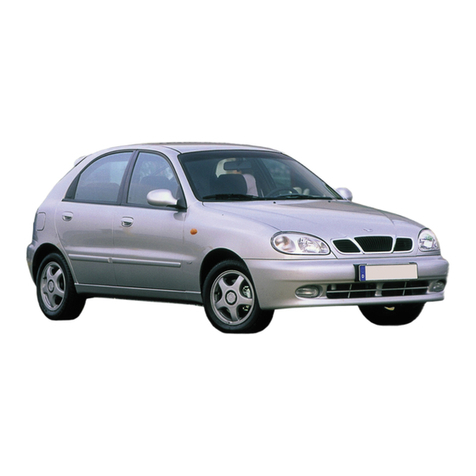
Daewoo
Daewoo NUBIRA User manual

Daewoo
Daewoo MUSSO User manual
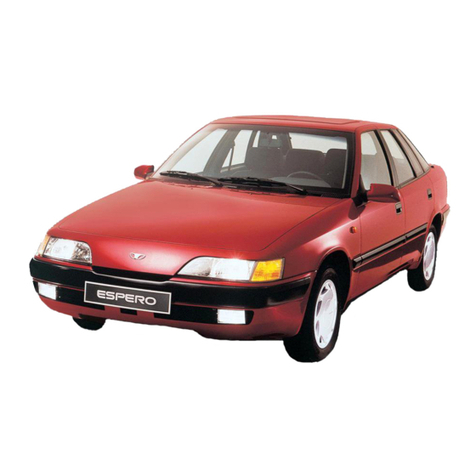
Daewoo
Daewoo Espero User manual
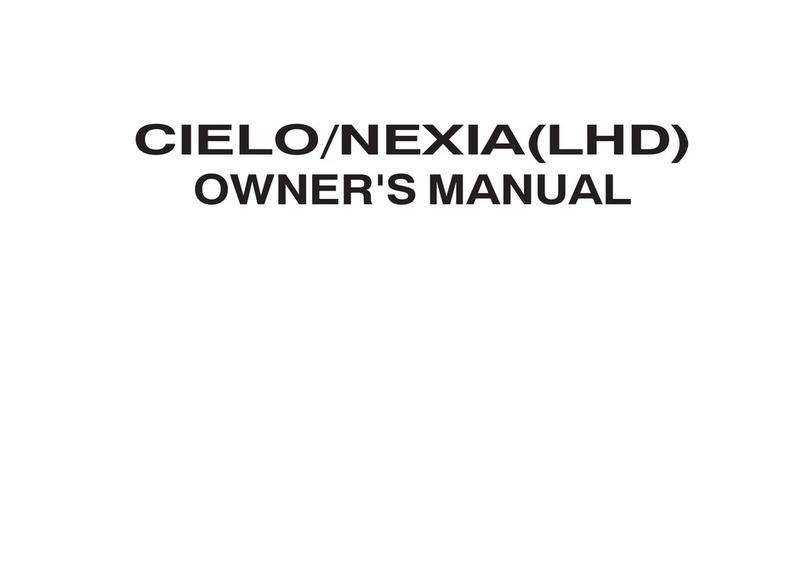
Daewoo
Daewoo Cielo User manual
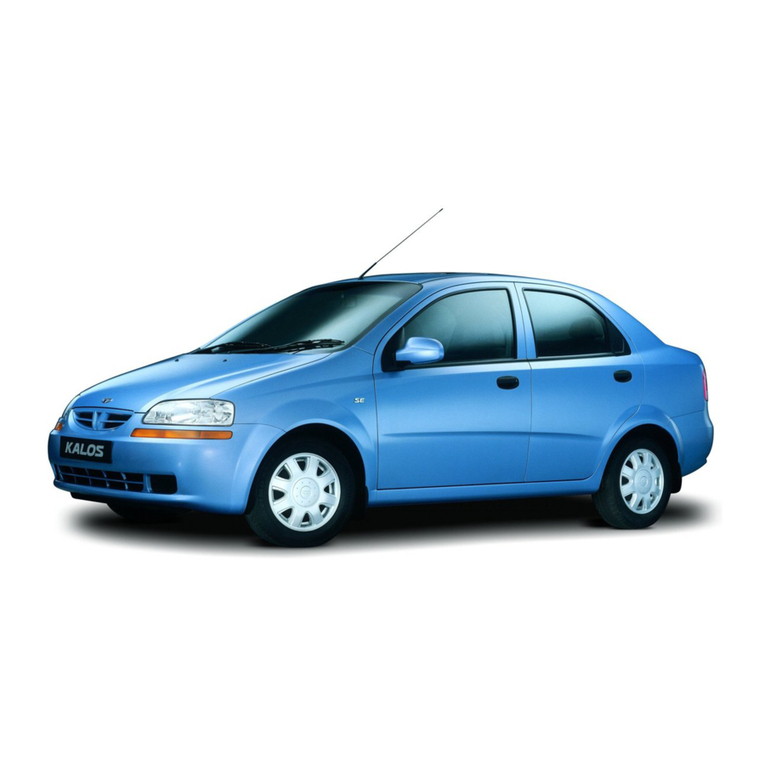
Daewoo
Daewoo Kalos User manual

Daewoo
Daewoo KORANDO User manual
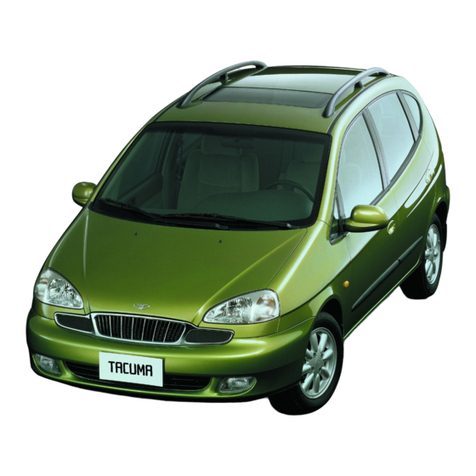
Daewoo
Daewoo TACUMA User manual

Daewoo
Daewoo NUBIRA User manual

Daewoo
Daewoo RACER 1998 Quick start guide

